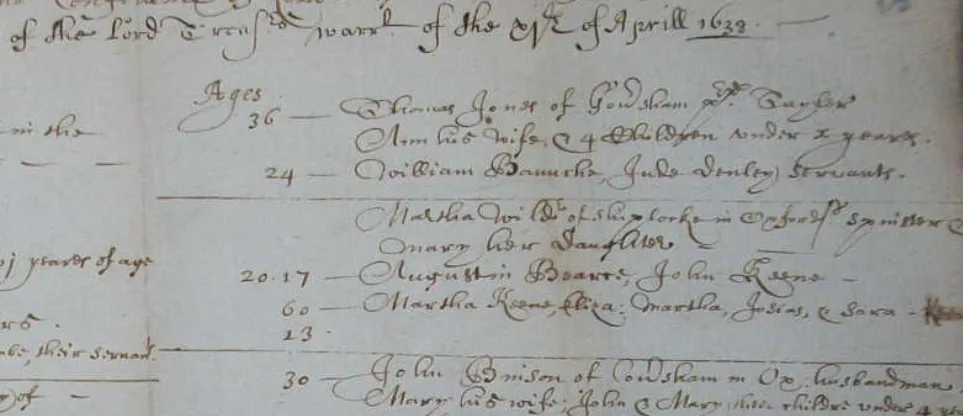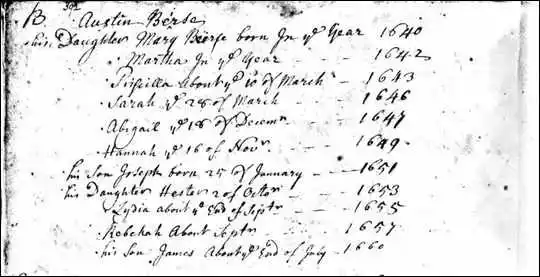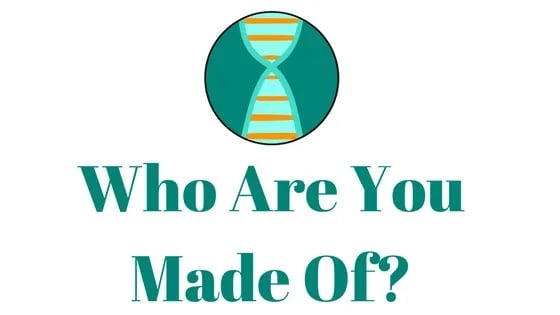Do you routinely include sources when you do family tree research? In this post, learn why you should always cite your sources on your family tree.

Several years ago, a cousin asked me if I knew anything about a line of our shared family tree that goes back to Massachusetts prior to the American Revolution. I told her that the furthest I had gone back on that line was to a man named Augustine or Austin Bearse, a man born in England in about 1618.

I mentioned to my cousin that there were conflicting stories online about his origins and that I wasn't really sure what to believe.
Some people said that his wife was a Native American named Mary Hyanno and that Augustine himself had Romani ancestry. Others said that the stories about his Romani ancestry and indigenous wife were completely made up.
Recently, my cousin contacted me to find out if I had been able to find out anything further about our ancestor, Augustine, my 9th great-grandfather. To be honest, I hadn't given Augustine much thought since I "discovered" him several years ago, but since my cousin was curious, I spent the last few weeks immersing myself in the stories and trying to discern fact vs. fiction.
The experience of trying to track down the origin of the conflicting stories about Augustine's life has been interesting, to say the least. I'm not sure that I know more about him than I did when I started, but I have learned something very important:
We should all be showing our work when we build our family trees and when we write about our ancestors. Below, I will explain why I believe this is so important through the rest of the story about Augustine.
Sources increase your credibility
People will take your family tree research more seriously if you have sources attached or included with your work. This is because sources increase credibility, and people who look at our work will be more likely to believe what we are saying about our ancestors when they can see the attached evidence.
One of the first things that I wondered about Augustine's story is how the stories about his Romani ancestry and his wife, Mary, came to be. This led me to a website that attributed the story to a man named Franklyn Bearce who sent the story in a handwritten manuscript to the Library of Congress around 1935.
The manuscript is filled with lots and lots of detail, but it is short on evidence of any of the claims that it makes, even the events that would be easy to prove. For example, Franklyn, the author, includes details about his recent pedigree.
It would have been easy enough to include an appendix with copies of the birth, death, and marriage certificates that he had access to at the time, but these were not included.
Franklyn, my seventh cousin three-times removed, also included lots of details about events in his family tree that were supposed to have happened much further back in time, and these were supposedly details that were either passed down to him via oral tradition or from a journal that was written by Augustine Bearse's grandson's wife.
Franklyn mentions having a few different lines of his tree, other than the line that we share, that he can trace to distinct indigenous ancestors. The way he describes it in his manuscript, his family was proud of this ancestry.
Unfortunately, there are no descendants that passed down stories about their shared Native American ancestry, which adds to the doubt about his story.
And as far as I can tell, no one else has ever seen the journal that Franklyn mentions in his writing.
If Franklyn had only included more of his sources in his work, people might have taken him more seriously in the 90 years since his work was printed.
You will make fewer mistakes
Another great reason to include sources in your family tree is that you will make fewer mistakes. This is because you will always have your sources and evidence right there in your tree when you come back to work on an ancestor again in the future.
Shortly after Franklyn Bearse sent his manuscript to the Library of Congress, part of his work was published by The Genealogical Society of Utah, in their July issue of The Utah Genealogical and Historical Magazine. The work caused an uproar in many genealogical circles.
The scandal around Franklyn's family genealogy led a Bearse family member to hire a well-known genealogist, Donald Lines Jacobus, to conduct an investigation into the claims to Native American ancestry.
I have not been able to figure out which Bearse family member hired the genealogist, or how closely related they were to Franklyn. If I find out, I'll be sure to update this article.
Jacobus published his analysis in his own genealogy magazine, The American Genealogist. Parts of his rebuttal are included in an analysis that I found about this topic on the Wikitree site.
There is a lot of information in the rebuttal, but one thing that I did notice is that if Franklyn had gone about his research with the intention of including his sources, he may not have included as many errors. The errors in his research definitely detract from the quality of his manuscript and make people less likely to believe what he is saying about his ancestors.
Unfortunately, many people have taken the undocumented information in Franklyn's manuscript as truth, and have included it in their family trees online. I even found it printed in a few genealogy books, and then found trees that include the genealogy books as their source.
All of this "noise" makes it difficult for people to try to dig through and discover that all of these assumptions are based on an un-sourced genealogy.
Sources will save you time in the future
If you include your sources, you will be less likely to repeat work that you have already done when you are researching a line of your tree. For example, if you include a year of birth for an ancestor but don't include the document from which you learned the date, you may not remember how you discovered this information next time you go to work on this ancestor.
I'm not sure how much time Franklyn spent working on his manuscript. Some people say that it is completely fabricated aside from his recent ancestors.
There are a lot of details included, and it seems like it would take a lot time and effort to make up such a thorough story. Even so, having sources would help us parse out truth from myth more easily.
Others can build on your work more easily
If we include sources in our family tree research, others that come in the future can more easily build upon the work that we have already done. We can save them time and help them discover even more about our ancestors by showing them our work.
I wish that Franklyn had had the foresight to include more sources with his work so we could understand his manuscript from his perspective and see things in the sources with the help of modern technology that he couldn't have noticed. Of course, I am giving him the benefit of the doubt and assuming that he did not intentionally publish a fraudulent genealogy with the goal of misleading people.
You can share sources with family members and other researchers
The final reason that I believe it is important to include our sources with our research is because it makes it easier to share what you have learned with family members and other people who are researching the same person.
I can't tell you how many times I've had a discussion with a close family member or cousin about something that I have discovered about an ancestor that has ended with them asking me for the original record where I discovered that fact. This is especially true when we find things that people might not believe or agree with about our ancestors.
If Franklyn had wanted to be taken seriously by the Bearse cousins who took interest in his published work, he should have included many more sources with his manuscript.
Conclusion
The story of the origins and wife of Augstine Bearse still remains largely a mystery. The only thing that we know for sure about him are about when and where he was born, when he came to North America, and the names of his children. Many people also say that his wife was called Mary, but no record of their marriage has been discovered.

As far as Franklyn's involvement with this story, there is a lot we might not ever learn. If he did make up this story, why did he do it? What were his motivations?
I did read one suggestion as to possible motivations. One person suggested that he wanted to join a Native American tribe in order obtain "benefits". This may be a result of people believing a common myth that was developed in more modern times and applying this to a moment in history.
When analyzing this possible motivation, we should remember that the manuscript was published in 1935. This is in the same time period that one of my ancestors was trying to cover up the Native American ancestor that she had discovered in her family tree.
Franklyn Bearse lived in Connecticut. In this state in 1935, land that belonged to Native American reservations was managed by typically white "overseers" who were supposed to make sure that the land was used appropriately for the benefit of the tribe, but it often didn't work out that way.
I'm not sure of what type of privileges Franklyn may have been entitled to had he been able to join a tribe in Connecticut during this time. Perhaps a reader can provide information (and sources!) about this.
I hope that you have enjoyed this article and that you have been inspired to make sure you thoroughly document your family work. If you have any questions or comments about this post, I would love to hear from you in the discussion below or by email.
Thank you for reading today!

Dennis J Cox
Wednesday 29th of October 2025
This happens all too often when those who believe "he/she who dies with the most direct and collateral ancestors wins" simply build a tree for numbers rather than quality. Quality takes time, numbers can be gotten out of a telephone directory, obit, newspaper articles, etc. most of which fail to PROVE the individual added to the tree. For that reason alone, when adding individuals from another person's work TRUST BUT VERIFY!
Mercedes
Sunday 9th of November 2025
Hi Dennis, I agree with everything that you said, 100%. It's a marathon, not a race. Thank you for taking the time to leave a comment! Sincerely, Mercedes
Pam
Tuesday 28th of October 2025
Fascinating! My brother and I are both adopted and Austin Bearse is his 9th ggf (researched by me then verified through family papers when he reunited). The story and questions around his life really caught my imagination and I've been trying to make sense of it. We may never know the whole truth about our ancestors, but it's an incredible experience discovering what is available. We've learned more about our respective families in the past two years than we ever thought possible. Thank you for sharing your research and process – and for reminding us all to always verify everything!!
Mercedes
Sunday 9th of November 2025
Hi Pam, Thank you for sharing your experience researching your brother's ancestry! I knew that there was a good chance that someone else out there had also been researching Austin Bearse. It certainly is an interesting story, and it's fun to try to find out as much as we can about these people who lived so long ago. Sincerely, Mercedes
Gail White
Monday 27th of October 2025
this sounds like a similar story in my own family, same general time frame. He too was a Franklin. John Franklin Carruthers. Genealogist involved, Gustav Anjou.